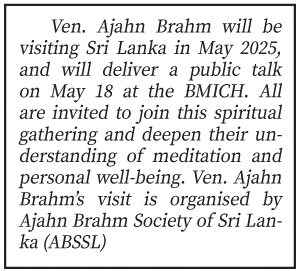Ajahn Brahm, a celebrated Buddhist bhikkhu and meditation guru, delivered an enlightening talk on the significance of posture in meditation on March 29, 2014. Known for his blend of humour and deep wisdom, Ajahn Brahm challenges traditional views of meditation, encouraging practitioners to focus on ease, awareness, and kindness rather than rigid postures.
This article delves into his teachings, emphasising the importance of relaxation, wisdom, and self-compassion in meditation.
Breaking the illusion of the “Ideal” posture
 Ajahn Brahm opens his talk by addressing a common question among meditators: “What is the right way to sit?” Contrary to popular belief, he explains that no single posture holds the key to effective meditation. Whether sitting cross-legged or in a chair, comfort is what matters most. He humorously dispels the myth of the perfect lotus posture, reminding us that the real goal is to be at ease with the body.
Ajahn Brahm opens his talk by addressing a common question among meditators: “What is the right way to sit?” Contrary to popular belief, he explains that no single posture holds the key to effective meditation. Whether sitting cross-legged or in a chair, comfort is what matters most. He humorously dispels the myth of the perfect lotus posture, reminding us that the real goal is to be at ease with the body.
How relaxation leads to deeper meditation
One of Ajahn Brahm’s core teachings is the idea that the body naturally knows how to position itself during meditation. He recounts a personal experience of meditating while ill, only to discover afterward that his body had relaxed into an unexpected, sprawled posture. This story highlights the importance of letting go of control and allowing the body to find its own way to comfort.
The gentle way to handle discomfort
Rather than forcing the body into rigid postures through sheer willpower, Ajahn Brahm encourages meditators to approach discomfort with wisdom. Observing discomfort with kindness and making small adjustments when necessary allows for a more compassionate and effective meditation practice, as opposed to simply enduring pain.
How letting go helps release tension and trauma
Ajahn Brahm shares a fascinating story of a woman whose body twisted into an unusual posture during deep meditation, only for her to feel refreshed afterward. This story emphasises the body’s natural healing abilities when we let go of controlling it, allowing tension and trauma to be released in subtle, powerful ways.
Responding to physical signals with compassion
Discomfort is inevitable during meditation, whether it’s an itchy nose or an aching knee. Ajahn Brahm likens these distractions to phone calls from different parts of the body. Rather than reacting impulsively, he advises meditators to acknowledge these sensations with wisdom and choose whether to respond or let them pass. The key is in balancing stillness with comfort.
The Link between physical comfort and mental calm
Ajahn Brahm teaches that physical relaxation is closely tied to mental stillness. Once the body is at ease, the mind can follow suit, leading to deeper states of meditation. He emphasises that just as we let go of controlling the body, we must also release control over the mind, observing thoughts with kindness rather than force.
Meditation as a journey of letting go
Ajahn Brahm’s reflections remind us that meditation is not about strict discipline but about letting go. By approaching both the body and the mind with kindness and wisdom, we allow ourselves to enter deeper states of relaxation and well-being. His philosophy invites us to trust in the body’s wisdom and embrace a more flexible, compassionate approach to meditation.
Join us and meditate https://youtu.be/mToqDCemp4c









